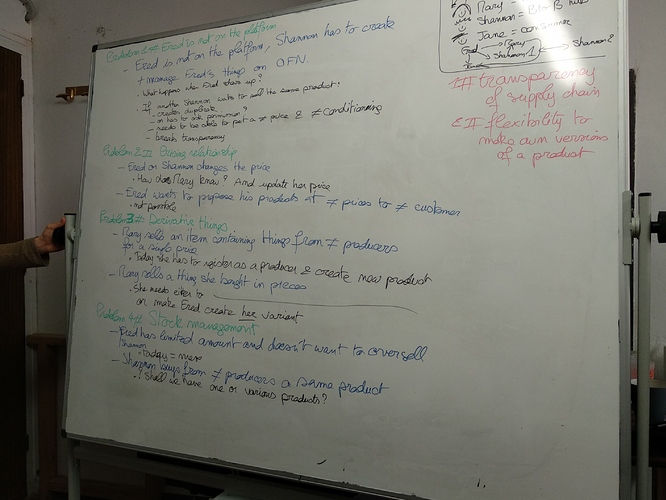Continuing discussion from Discovery Session: Networks (WIP) and first inception from Myriam A first iteration on product chain logic enabling full transparency.
A- Reminder: what are the problems/needs
B- The data model we ended up with and that seems to handle all the cases we could think about
Agents
(Agent_ID / Agent_name)
Products
(Product_ID / Agent_ID / Product_name / Product_description)
Every product line will represent one “unit”. Then in the description we can detail if one “unit” is an item, or a number of kg or L, we don’t have to detail it here.
Products relationships
(Product_relationship_ID / Product_ID / Origin_Product_ID)
As soon as an agent creates a new product ID, a new Product relationship is created:
- if the product is a “source” product (the raw product from the original producer) the Origin_Product_ID will be empty.
- if the product is a “derivated product” we want to encourage users to specify from which product(s) they created the new product:
- A derivated product can have a single origin (ex: buy potatoes by kg > sell potatoes by bags of 5 kg). If the derivated product is a perfect copy of the origin product (when Mary buys a product to Fred for instance and she receives the product and it is added to her inventory) a new product is created under the new agent ownership, and connected to the origin product (the product from the supplier he bought it from).
- Or a multi-origin (ex: buy potatoes by kg + carrots by kg > sell vegetable baskets by item)
Products recipes / stock recipe…
(to be renamed maybe + we don’t know yet how/when we store the data but we know we need “recipes”).
When a new product relationship is created, we need the user to give the “recipe” of the new product, for example:
- New product A comes from both B and C (product relationship)
- AND Recipe : A = 2 x B + 1 x C
This will enable to manage stock all along the chain.
C- Two examples detailed so that you understand the logic
Let’s add a “stock movement table” in this example to show how that is going to work.
a- Compound derivated product
Ex: Mary buys vegetable to Fred and sells weekly vegetable baskets to Jane
Look at “aggregation” tab here to see the case: 'https://docs.google.com/spreadsheets/d/1_FUBRqC0W_nrThR6rE59eHEffCjfFy-lbSeI7kJ0w0A/edit#gid=480003136
b- Split derivated product
Ex: Mary buy an apple box of 100kg from Shannon and sells apple bags of 1kg to Jane
Look at “split” tab here to see the case:
'https://docs.google.com/spreadsheets/d/1_FUBRqC0W_nrThR6rE59eHEffCjfFy-lbSeI7kJ0w0A/edit#gid=1836728487
D- Next steps
[UPDATED by Myriam 08/07/2018]
THIS HAS NOT BEEN PRIORITIZED YET. Inception can move forward but nothing will happen on it before Q4 2018 or Q1 2019.
1- Enrico, Pau and Hugo proposed to build a quick prototype so that we can test and make sure all the cases we can think about are going to fit in it. Estimated time needed: 2/3 days.
2- Rachel and I wrote the following user stories for them to fuel their prototype. In this we started with simple cases but also ended up with very complex ones like Alterconso case and it seems that the model handle all the cases perfectly (For Alterconso part of the problem will be solved by delivery note – see other thread on delivery note to come)
3- When we have that prototype you can all test if that cover what we want and we can then start to break all that in stories and work on UX (UX will be a BIG job in here). Rachel and I might have a first go at it meanwhile the prototype is developed.
4- This feature is BIG and impact all the OFN basically:
We discussed about what was the very smaller step we could do toward that and more generally the network feature. We agreed the first bit would be customer categories / pricing tables that we could implement without starting to touch everything in the OFN. @Rachel and Myriam started to incept on it and Rachel is gonna open a new thread to present the first ideas we had, so that we can slowly start to get our heads around on how we gonna do it for when it is prioritized

